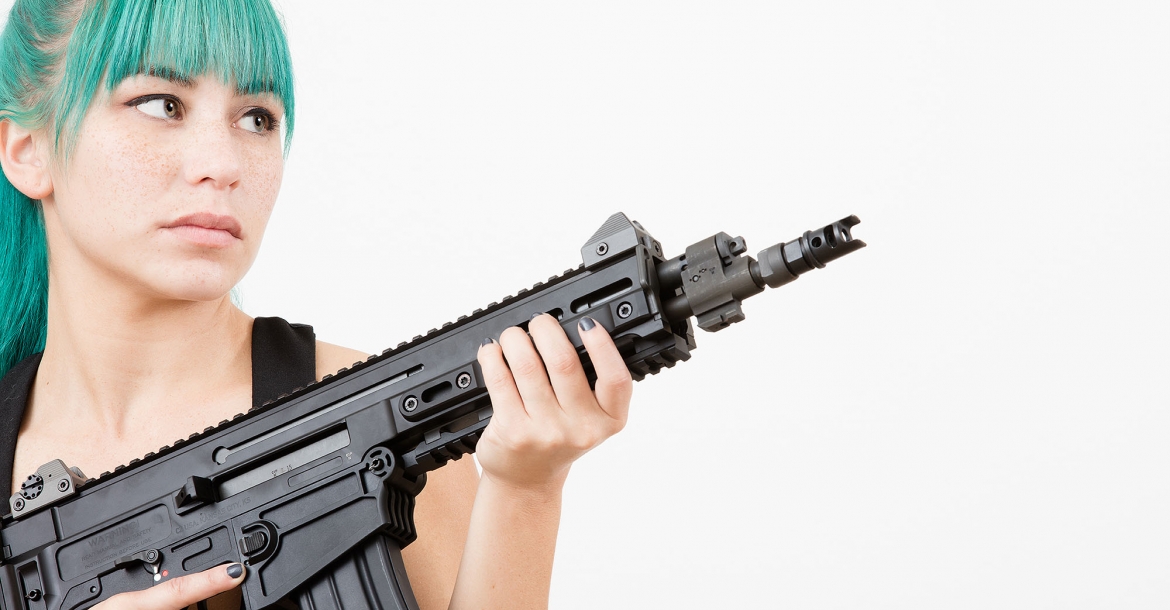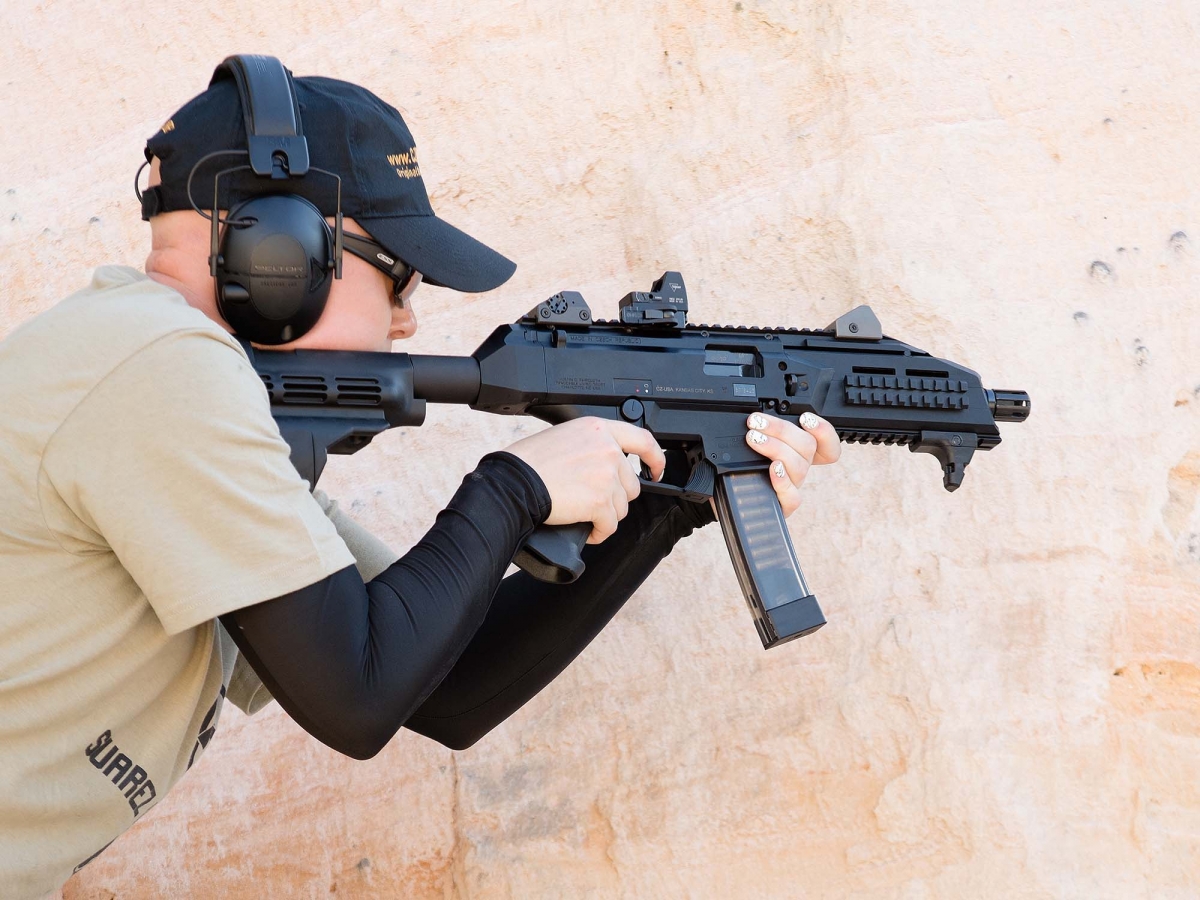CZ and the Czech School of Gunmaking: the international days
Hunting, sporting, defensive, and tactical firearms manufactured by Česká Zbrojovka are among the world's best, and our top writer/photographer Oleg Volk got a chance to try out some!
by Oleg Volk
A name carved in history
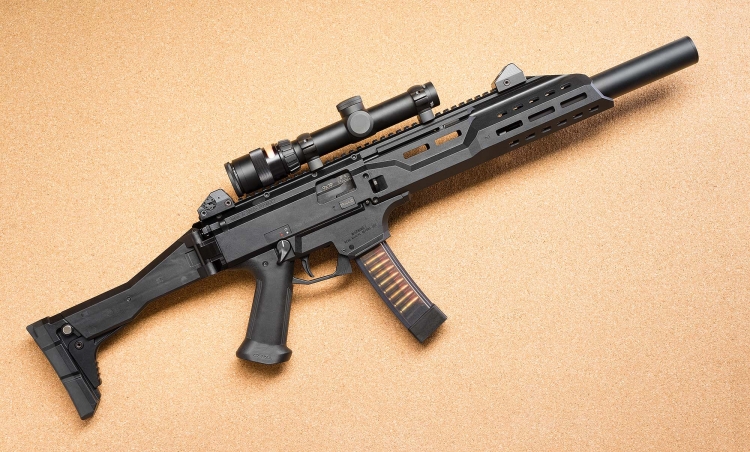
A long-barrel version of the CZ Scorpion EVO-3 S1 semi-automatic carbine, as distributed on the north American market
Czechoslovakia started domestic arms manufacturing as soon as the Country formed in 1918 out of the shards of the Austro-Hungarian Empire. As with companies like Steyr, some Czech arms makers also produced vehicles.
With Germany and Austria knocked out of the military firearms market, Czechoslovakia filled in much of the gap.
Pre-WW2 designs were a mix of classics, like Mauser pattern rifles, and original designs, often over-complicated but still functional. Of particular interest was the ZB26 8mm light machine gun which, in .303 caliber, became the British BREN. The name was derived from the development locations, BRno+ENfield.
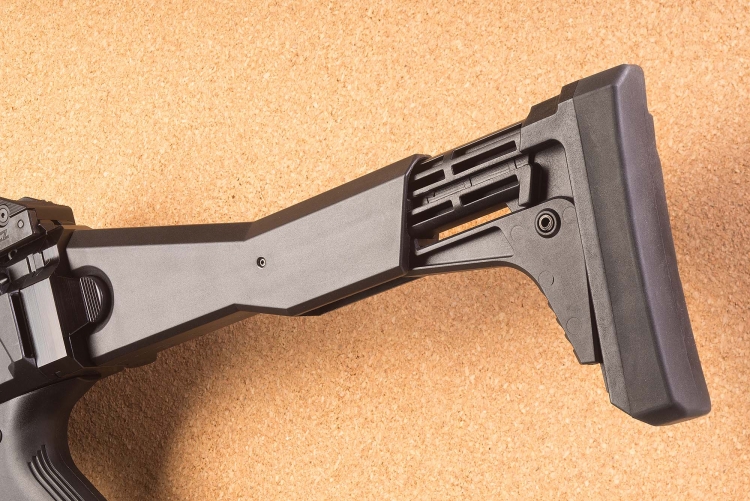
The side-folding and adjustable stock of the CZ Scorpion EVO-3 S1 carbine
After WW2, Czechoslovak designs continued to stand out from the mainstream. For example, The Vz.58 automatic rifle was a successful lightweight firearm that used features more typical of pistols; the Vz.52 light machine gun looked conventional but uniquely used the sliding pistol grip for cocking the action; and the Vz.52 pistol borrowed machine gun lockup arrangement to tame the powerful 7.62x25mm cartridge.
The best-known Czech firearm of all times, designed by the Česká Zbrojovka factory at Uhersky Brod, is probably the CZ-75 semi-automatic pistol. A locked-breech, double action 9mm pistol, it was the best Comblock handgun in existence.
From niche to global success
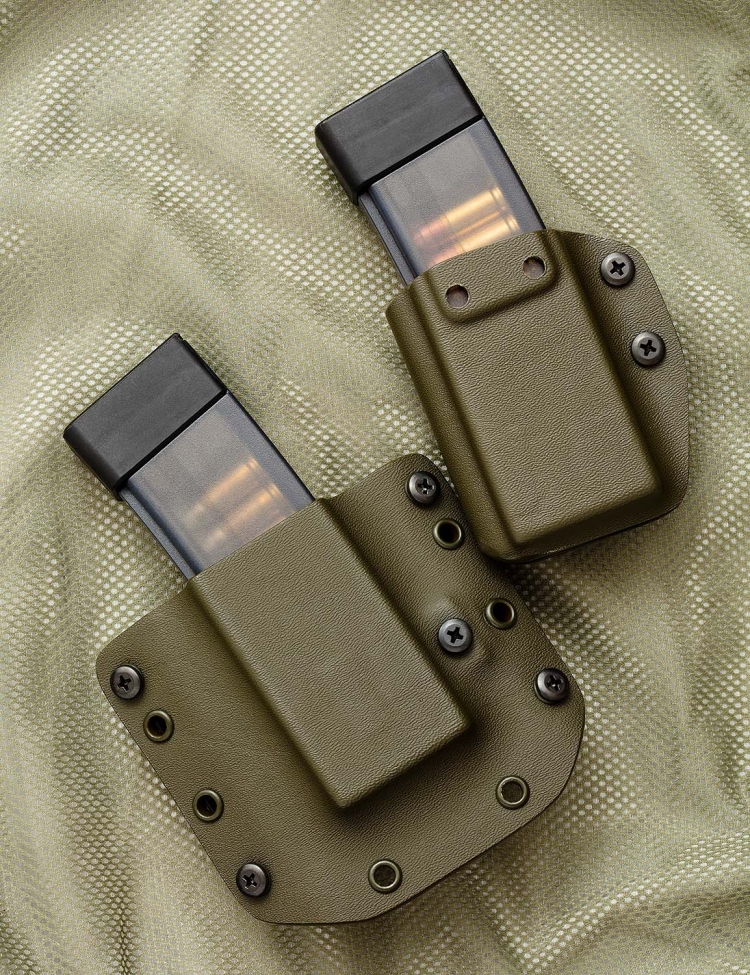
It is safe to state that CZ is currently a common household name among firearm enthusiasts worldwide
Photo by Oleg Volk
Magazine pouch manufactured by Fury Carry Solutions
As the Warsaw Pact block disintegrated, more of the fine Czech and Slovak arms became available in the West. From CZUB, mainly civilian variants of military pistols, rifles and submachine were offered, along with very desirable bolt actions. Favorable exchange rates allowed the relatively unknown brand to get established in the US and eventually become known more for high quality. Driven more by consumer demand, Czech firearm offerings became closer to the European and American mainstream.
Most recently, the mainstreaming also affected their military arms. The CZ 805 BREN, a 5.56x45mm assault rifle developed in 2006, was made modular to fit proprietary Czech, NATO or G36 magazines.
Developed to compete with FN SCAR-L, the CZ 805 is visually similar to several European offerings and competes more on the quality of manufacturing than on the originality of the mechanism. Similarly, the Scorpion EVO 3 A1 sub-machinegun, the EVO 3 S1 semi-automatic civilian-grade long-barrel and short-barrel carbines and the EVO 3 P1 civilian pistol based on it are all conventional closed-bolt blowback weapons, distinguishable from the competition mainly by the modularity and superior fit and finish.
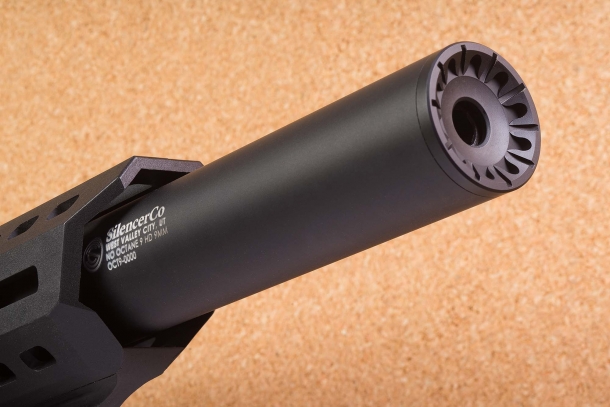
The long-barrel Scorpion EVO carbine sold in the United States features a 16" long barrel masked by a faux suppressor
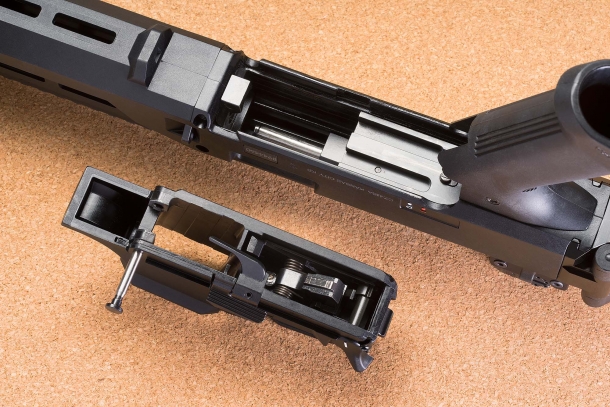
The trigger group of the CZ Scorpion EVO 3 A1 sub-machinegun and of its civilian-grade counterparts is easily removed from the frame
The CZ Scorpion EVO
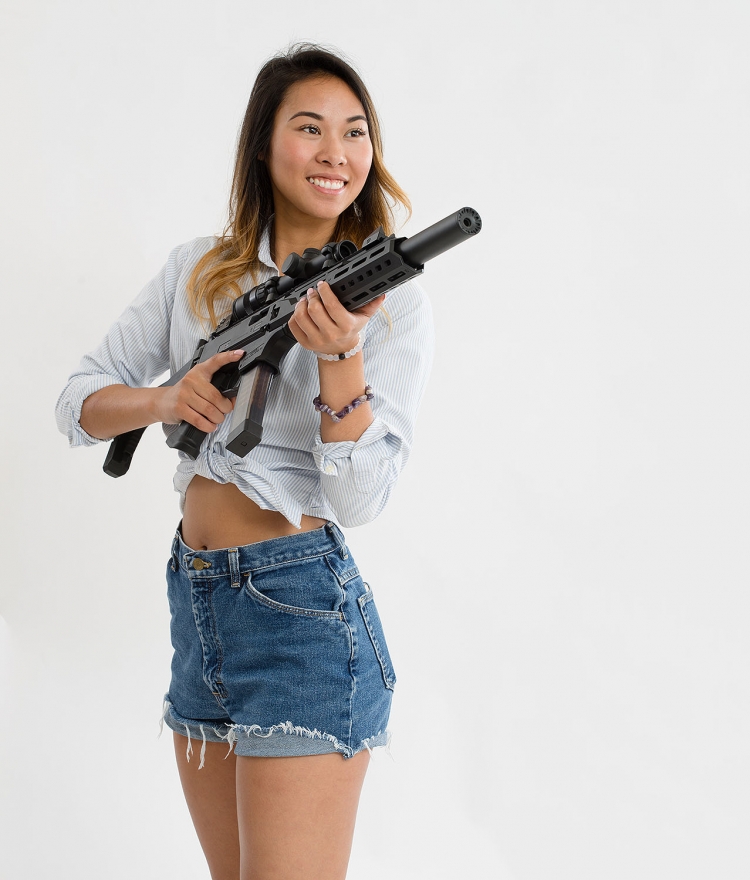
In its civilian-grade variants, the CZ Scorpion EVO 3 is a practical and reliable carbine, subcarbine or pistol for leisure shooting, training, competition, home protection, or self-defense
The third generation of guns to bear the "Scorpion" name shares nothing with its Vz.61 predecessor save the name. It uses a conventional rear-placed blowback bolt and chambers 9x19 Parabellum cartridge. The submachine gun version has been adopted by about a dozen countries, mainly for police use.
For compliance with US regulations, the carbine is semi-auto only and the barrel is 16.2” instead of the original 7.8” of the Scorpion EVO 3 S1 which is commonly available to civilian shooters in Europe. The customer may choose a muzzle brake or a faux sound suppressor that acts as a barrel shroud. The muzzle is threaded 1/2x28 to accept real sound suppressors.
Overall unloaded weight is 6.2lbs. The carbine comes with a 20-round double-stack double-feed magazine of translucent polymer. It is very easy to load and no tool is required. The same is true of the optional 30-rounder.

The CZ Scorpion EVO 3 will accept 20-rounds or 30-rounds magazines
The bolt will lock back on an empty magazine, and may also be locked back manually with the lever on the left of the polymer receiver. Magazine release and safety levers are ambidextrous. The telescoping stock offers a good cheek weld, may be folded to the right for travel carry. Disassembly for cleaning is extremely simple, with one pin holding the trigger group and another the stock. Once those are off the receiver, the bolt and the recoil system come out of the back.
Non-reciprocating charging handle can be swapped from the left side to the sight if desired. The front sight is adjustable for elevation, the rear for windage.
The carbine comes pre-sighted for 55 yards (50 meters). The rear sight has four different detented apertures available by flipping, but all four have the same elevation. Apparently, they are provided for accommodating different ambient light levels. The racked back front of the receiver makes the sight radius needlessly short, but it's of little practical concern, as a red dot or a scope is the more likely primary sight for this gun
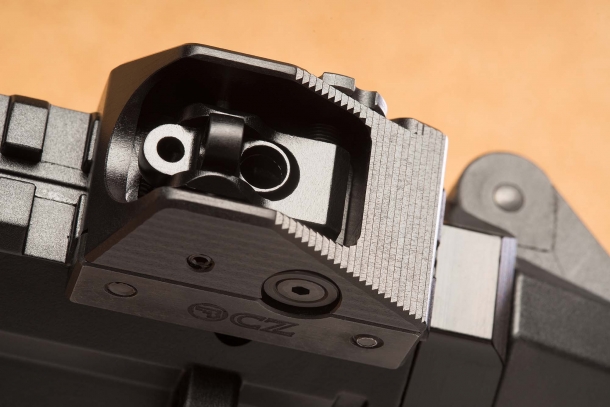
The adjustable rear sight of the CZ Scorpion EVO 3
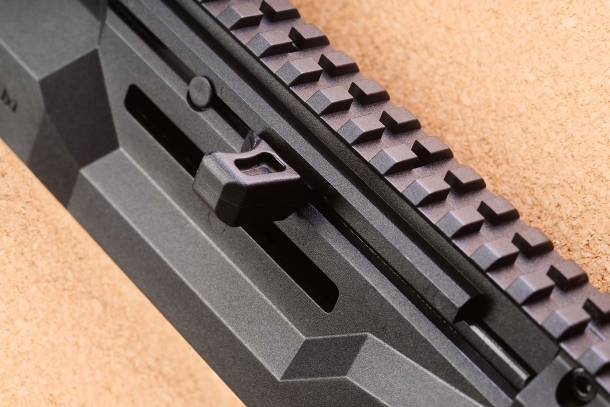
The charging handle of the CZ Scorpion EVO 3 is reversible
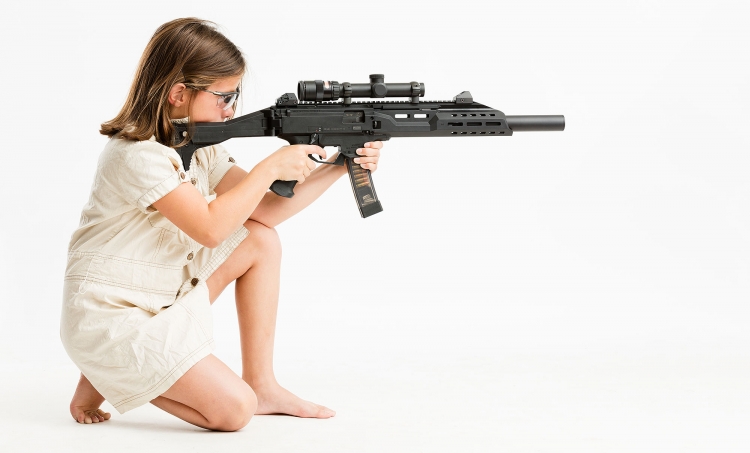
The CZ Scorpion EVO 3 is a reliable, accurate, and well-balanced firearm
True to its automatic roots, the Scorpion doesn't heat up much during rapid firing. Felt recoil is very moderate for a simple blowback gun, but the pistol grip flexes a bit. Reliability has been 100% with all ammunition from 50 grain hypervelocity Liberty fragmenting hollow points to 147 grain subsonics and everything in between. Felt recoil increased with the bullet weight, which is typical. The legally mandated long barrel does have two tangible benefits: reduced muzzle blast and improve performance. While most loads gain only moderately, some showed outstanding results.

The 7.5" version of the CZ Scorpion EVO 3 is sold on the U.S. market as a stockless pistol and can be fit with an armbrace
Soon to be available from Makers Bullets, carbine-specific 9mm loads yielded 1500fps with 115gr all-copper hollow point and 1850fps with low-recoil 75gr bullet. Liberty Civil Defense 50gr clocked in at 2550fps, fast enough to generate hydrostatic shock.
Even better, ten-shot groups from it at 25 yards were 0.7”, 2.8MOA – pretty respectable for a hypervelocity load. Advanced Ballistic Concepts Zeurillium (zinc) alloy 88gr bullets developed 1450fps and grouped even better, 0.6” or 2.4MOA. Other loads grouped closer to 1” at 25, still a decent result for ten-shot groups from a pistol-cartridge carbine.

A 10-shots group at 25 yards with the CZ Scorpion EVO 3 carbine
The slight drop stock configuration isn't enough to cause muzzle rise but permits very low scope mounting. The Trijicon Accupoint 1-4x I used actually touched the rail with the ocular bell. The iron sight height over bore is under 2 inches, with the centerline of the 30mm scope tube at 2.5”. Set to 1x, the scope worked well as a red dot sight, and at 4x enabled precision shooting at longer ranges.
I had several ergonomic concerns with the Scorpion, starting with the ambidextrous safety lever digging into the top of my hand when on FIRE. I also felt that the charging handle needed to be longer to avoid possible interference of the hand and the optic or the top of the Picatinny rail. The stock trigger is quite heavy, around 8 pounds. Fortunately, all of those are addressed by HB Industries and Gear Head Works at small cost. Overall, the carbine is accurate, reliable and well balanced.
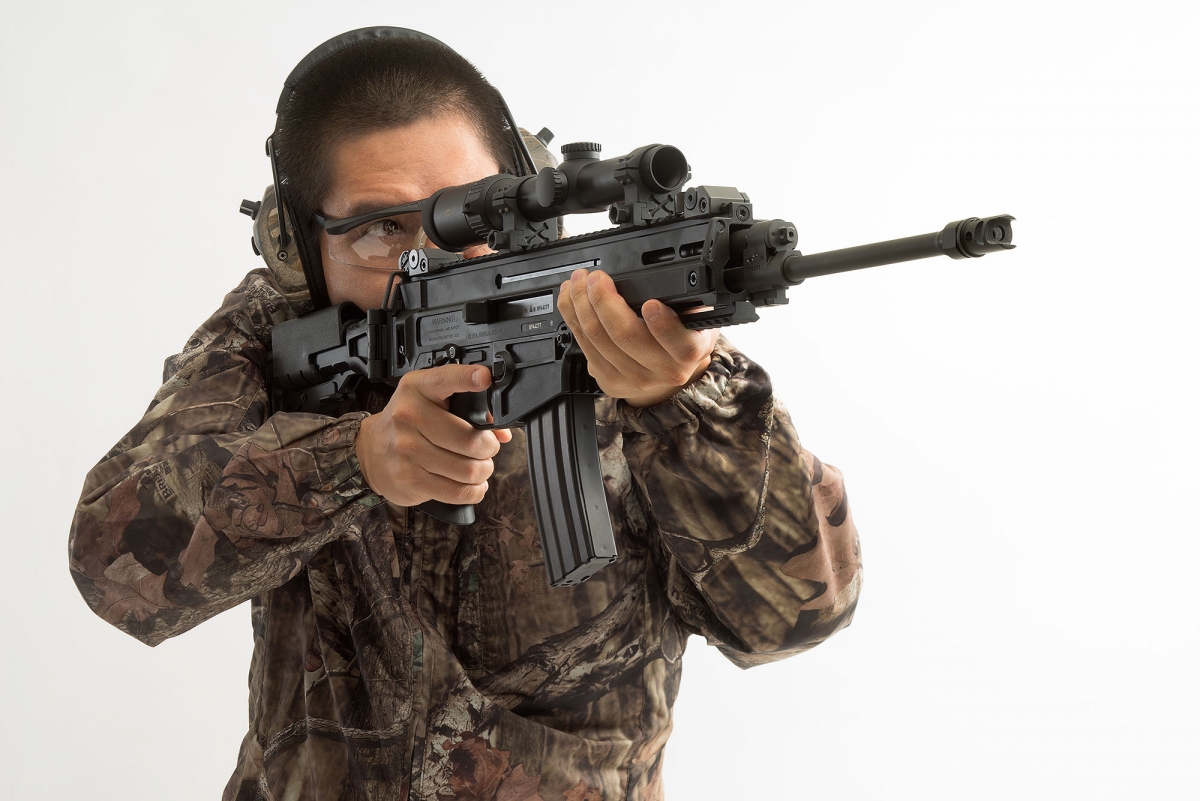
The CZ Bren 805 S1 carbine is a semi-automatic version of the BREN A1 assault rifle
The CZ 805 BREN S1
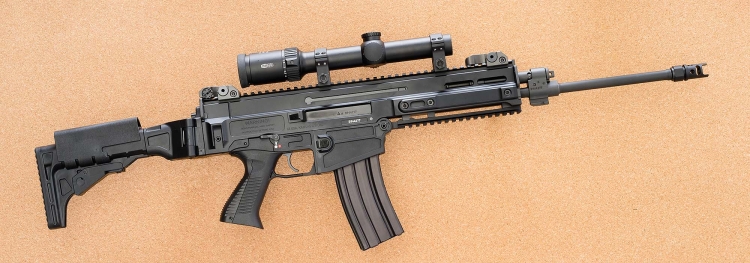
The CZ 805 BREN S1 semi-automatic carbine, seen from the right side
The CZ 805 BREN S1 is a gas-operated rifle using a short-stroke piston with integral return spring. At 8 pounds, it feels quite substantial. Polymer lower receiver and buttstock combined with monolithic aluminum upper make it balance rather differently from an AR15.
The magazine well is a separate part and may be interchanged, though only 5.56mm STANAG version is currently offered in the US. The 16.2” barrel is surprisingly light in comparison to the beefy railed forend. Gas regulator has two positions, for regular shooting and for suppressed use.
Like the Scorpion EVO 3, the CZ 805 comes with ambidextrous safety but implements it better, so there's no interferance. The reciprocating charging handle dubs as a forward assist. It can be switched from left to right. It's positioned far enough back to not interfere with the support hand, except in case of mag well hold with a high thumb.
The bolt hold-open button is just above the mag release on the left, but it doesn't close the bolt. The mag release is ambidextrous as well.

The gas regulator of the CZ 805 BREN S1

The CZ 805 Bren S1 semi-automatic rifle, field-stripped
The folding telescoping stock was originally designed to permit firing from transport position. However, the inclusion of a raised cheekrest makes that problematic. The stock looks a little awkward but actually functions very well, giving a consistent hold and good recoil absorption. Pistol grip accepts interchangeable backstraps.
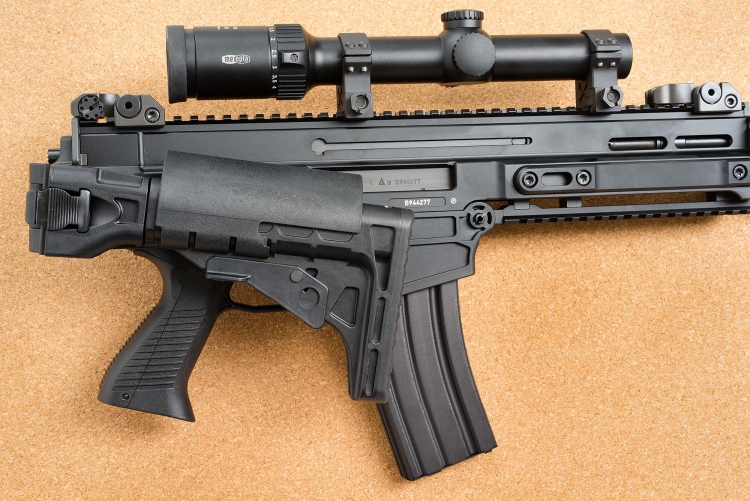
The stock of the CZ 805 BREN S1 rifle folds sideways for transport and can be extended to match the build of any shooter
Reliability was the same 100% typical for CZ products. Accuracy depended greatly on the ammunition used. Federal Gold Match 69gr gave 1.2MOA and would probably do better had I tested with a parallax-adjustable scope. I suspect that 75-77gr match ammunition will be the most accurate, but have not had a chance to verify.
The 1:7 barrel even stabilized Allegiance Ammunition Silent Strike 110gr bullets intended for suppressed use. That load, the inexpensive 62gr Freedom Munitions FMJ and 65gr OATH shot 3MOA. The worst performance came from PPU 62gr FMJBT – patterns around 8MOA.
A very nice two stage trigger definitely helps practical accuracy.
What didn't help was the muzzle brake: it was quite concussive and threw enough gunk back that it reflected off the range partition and hit the shooter on the side of the face. I would recommend replacing it with a flash hider or a linear compensator. The gun doesn't produce enough recoil to justify a muzzle brake anyway. The muzzle is threaded 1/2x28, same as AR15.
Take-down for cleaning is as simple as with Scorpion: one pin to pull the fire control group, another to take off the stock and pull out the bolt, carrier and the gas system. It's one of the simplest rifles I've seen in terms of maintenance. It is also one of the cleanest, with almost no perceptible residue forming during all of my testing.

The CZ BREN 805 rifle features an aluminum alloy upper receiver and a polymer lower
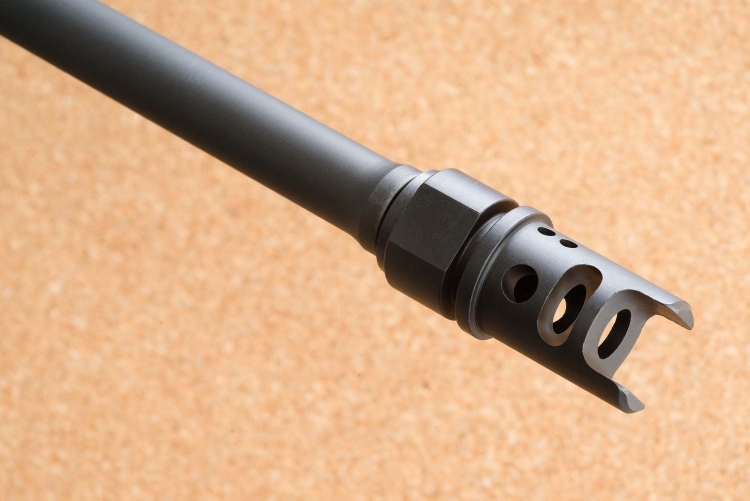
The muzzle brake of the CZ 805 BREN S1 carbine
To stick with the Czech theme, I used an illuminated Meopta R2 1-6x scope. Founded in 1933, Meopta Optics is located in Prerov, 30 miles NE of Brno. Their scopes are on par with the best premium brands while relatively affordable and lightweight.
The R2 works as a red dot at true 1x with a very wide field of view. Up close, it makes targeting with Bren 805 almost transparent. The scope was free from flare and gave excellent brightness and clarity even in low light. Even at full zoom, the eyebox was sufficient for comfortable and rapid sighting. While the R2 is quite long, it left enough room for folding backup sights.
The long eye relief allowed mounting the scope in front of the rear sight rather than above it, reducing the height over bore. The heavy duplex reticle is simple relative to the competition, limiting the rangefinding options but providing a very uncluttered view. However, the 2MOA center dot can be used in conjunction with 25MOA thin section of the duplex reticle. For example, with 40/280 yard zero for 62gr ball, a typical person would fit between the dot and the top of thick post exactly at the far zero. For a rifle intended for typical combat ranges under 300 meters, that's a reasonable solution.
In sum, Czech gunmaking has progressed from quirky but functional to mainstream and functional. The fit and finish are top-notch, and accuracy is on par with the best US designs.

